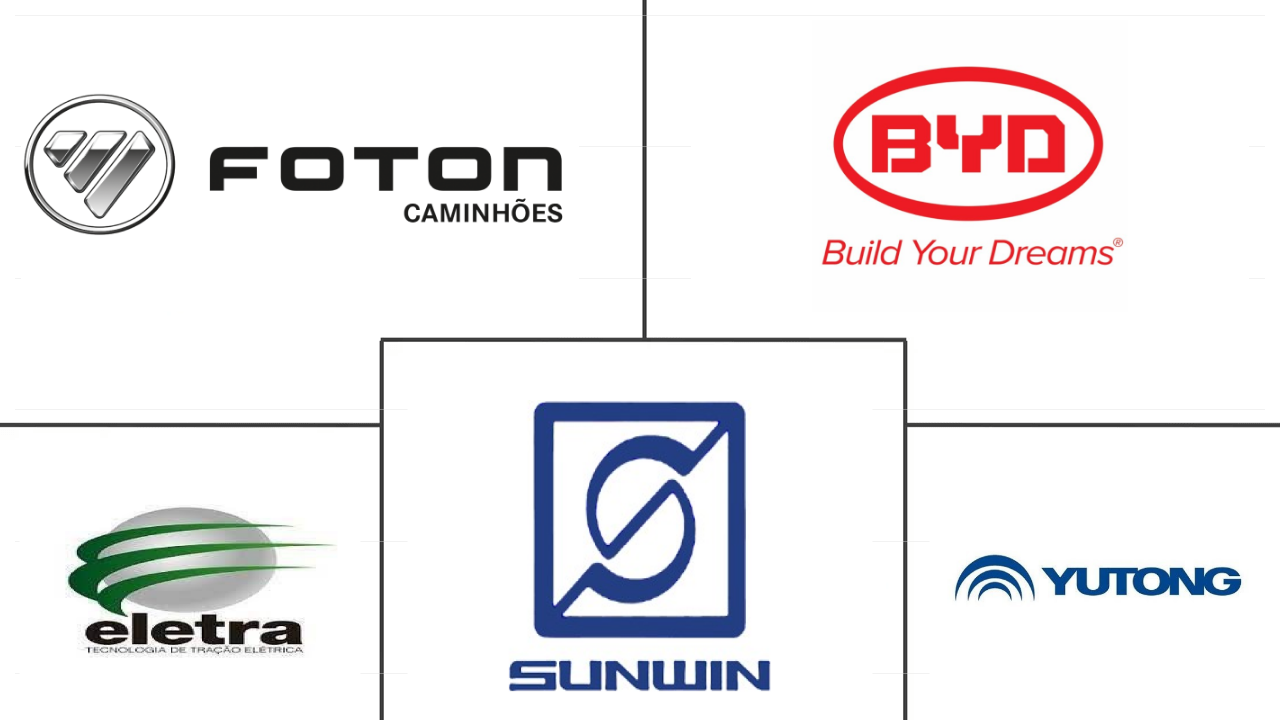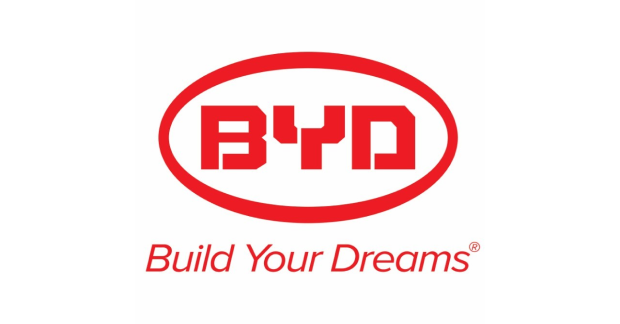Market Size of south america electric bus Industry
|
|
Study Period | 2017 - 2030 |
|
|
Market Size (2024) | USD 0.43 Billion |
|
|
Market Size (2030) | USD 1.23 Billion |
|
|
Largest Share by Fuel Category | BEV |
|
|
CAGR (2024 - 2030) | 19.41 % |
|
|
Largest Share by Country | Brazil |
Major Players |
||

|
||
|
*Disclaimer: Major Players sorted in no particular order |
South America Electric Bus Market Analysis
The South America Electric Bus Market size is estimated at 0.43 billion USD in 2024, and is expected to reach 1.23 billion USD by 2030, growing at a CAGR of 19.41% during the forecast period (2024-2030).
0.43 Billion
Market Size in 2024 (USD)
1.23 Billion
Market Size in 2030 (USD)
61.63 %
CAGR (2017-2023)
19.41 %
CAGR (2024-2030)
Largest Segment by Fuel Category
82.39 %
value share, BEV, 2023
BEVs dominate due to government incentives, lower operational costs, and urban demand for cleaner public transportation options in South America.
Fastest-growing Segment by Fuel Category
20.50 %
Projected CAGR, BEV, 2024-2030
BEVs are rapidly growing due to strong government support, expanding charging infrastructure, and increasing environmental awareness among urban populations.
Largest Country Market
32.23 %
value share, Brazil, 2023
Brazil leads the electric bus market due to significant investments in public transportation, government support for EVs, and a large urban population requiring efficient transit solutions.
Fastest-growing Segment by Country
19.78 %
Projected CAGR, Brazil, 2024-2030
Brazil is the fastest-growing segment due to increasing investment in electric bus fleets, government incentives, and expanding urban infrastructure.
Leading Market Player
50.81 %
market share, Byd Auto Industry Company Limited, 2023

Commitment to innovation and development activities, various electric bus models offerings, and well-established network keeps Byd in top in South America electric bus market.
South American E-bus market: Paving the way for greener urban mobility
- BYD is one of the top companies in the electric bus market. The company continuously creates brand-new electric buses with cutting-edge technologies that meet various standards. For instance, in March 2021, BYD announced the arrival of the country's first locally produced all-electric bus in Campos. The variant is 22 meters long and has lithium iron phosphate batteries with a three-hour charge capacity that allows for a 250 km range. The bus has 168 seats. BYD also makes significant investments in the globalization of its corporate operations. With 386 all-electric buses in Chile as of October 2021, BYD held about 74% market share for electric buses in Chile.
- Over 390,000 buses circulate across Brazil, but a meager 247 are electric. Only eight cities in Brazil have electric buses, with only a handful in each. Even cities that have been most enthusiastic about electrification, such as São Paulo, where a recent law established a goal of zero pollutants from transport within 20 years, have been slow to increase their fleets.
- Brazil holds potential demand for electric buses as the country is focusing on the adoption of more renewable power generation, which may utilize the country’s large niobium and lithium reserves, a crucial factor for EV batteries’ development. São Paulo’s public transport authority, SPTrans, plans to deploy 7,000 electric buses on the streets over the next 10 years.
The adoption of electric buses in South American countries is uneven but promising, indicating a regional dedication to cleaner public transportation
- South America has the highest use of buses per person globally. With a growing Bus Rapid Transit System, nearly 19 million passengers have been identified as traveling through BRT services across several cities in the region. To support this growing demand, many municipalities in the region have started working on expanding public transit options into less-served areas, where cleaner buses may play a vital role in filling the gaps.
- Several countries in the region are adopting measures to meet the rising demand for electric buses. In August 2022, Marcopolo announced the series production of its first electric bus with its own chassis. Marcopolo will produce 30 of the new Attivi electric buses that will be deployed in Brazil and later to other countries. Such activities are expected to attract customers, which further will increase the demand for electric buses across the region.
- Various states in various countries across the region are planning to deploy electric buses to increase sustainable transportation and cut down the carbon emissions. In December 2022, Sao Paulo, Brazil, announced to ban the diesel and planned to deploy 2600 electric buses by the end of 2024. The deployment of the electric buses will boost the electric bus industry in Brazil, which further will enhance electric mobility across the region.
South America Electric Bus Industry Segmentation
BEV, HEV are covered as segments by Fuel Category. Argentina, Brazil, Rest-of-South America are covered as segments by Country.
- BYD is one of the top companies in the electric bus market. The company continuously creates brand-new electric buses with cutting-edge technologies that meet various standards. For instance, in March 2021, BYD announced the arrival of the country's first locally produced all-electric bus in Campos. The variant is 22 meters long and has lithium iron phosphate batteries with a three-hour charge capacity that allows for a 250 km range. The bus has 168 seats. BYD also makes significant investments in the globalization of its corporate operations. With 386 all-electric buses in Chile as of October 2021, BYD held about 74% market share for electric buses in Chile.
- Over 390,000 buses circulate across Brazil, but a meager 247 are electric. Only eight cities in Brazil have electric buses, with only a handful in each. Even cities that have been most enthusiastic about electrification, such as São Paulo, where a recent law established a goal of zero pollutants from transport within 20 years, have been slow to increase their fleets.
- Brazil holds potential demand for electric buses as the country is focusing on the adoption of more renewable power generation, which may utilize the country’s large niobium and lithium reserves, a crucial factor for EV batteries’ development. São Paulo’s public transport authority, SPTrans, plans to deploy 7,000 electric buses on the streets over the next 10 years.
| Fuel Category | |
| BEV | |
| HEV |
| Country | |
| Argentina | |
| Brazil | |
| Rest-of-South America |
South America Electric Bus Market Size Summary
The South America Electric Bus Market is experiencing significant growth, driven by increasing demand for sustainable transportation solutions and government initiatives promoting electric vehicle adoption. The region, known for its high bus usage per capita, is witnessing a shift towards electric buses as municipalities expand public transit options and aim to reduce carbon emissions. Key players like BYD and Marcopolo are actively contributing to this transformation by introducing innovative electric bus models and expanding production capabilities. Brazil, in particular, is focusing on leveraging its renewable energy resources and abundant mineral reserves to support the development of electric buses, with cities like S√£o Paulo leading the charge by setting ambitious targets for electrification.
The market landscape is fairly consolidated, with major companies such as Beiqi Foton Motor Co. Ltd., BYD Auto Industry Company Limited, and others dominating the scene. Government policies and incentives are crucial in driving the adoption of electric buses across the region, with countries like Colombia setting ambitious targets to reduce carbon emissions. The South American vehicle industry is poised for growth, with electric buses playing a pivotal role in the region's transition towards cleaner transportation. As the market evolves, collaborations and strategic partnerships, such as those seen with Volvo Energy and Connected Energy, are expected to further enhance the development and deployment of electric bus technologies.
South America Electric Bus Market Size - Table of Contents
-
1. MARKET SEGMENTATION (includes market size in Value in USD and Volume, Forecasts up to 2030 and analysis of growth prospects)
-
1.1 Fuel Category
-
1.1.1 BEV
-
1.1.2 HEV
-
-
1.2 Country
-
1.2.1 Argentina
-
1.2.2 Brazil
-
1.2.3 Rest-of-South America
-
-
South America Electric Bus Market Size FAQs
How big is the South America Electric Bus Market?
The South America Electric Bus Market size is expected to reach USD 425.83 million in 2024 and grow at a CAGR of 19.41% to reach USD 1.23 billion by 2030.
What is the current South America Electric Bus Market size?
In 2024, the South America Electric Bus Market size is expected to reach USD 425.83 million.

